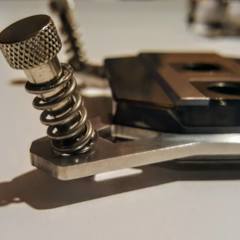
ToastyBear
Member-
Posts
109 -
Joined
-
Last visited
Awards
This user doesn't have any awards
Recent Profile Visitors
718 profile views
ToastyBear's Achievements
-
It depends. Laptop HDDs have never been good to me or anything for that matter. But that probably has more to do with people moving the laptop while the HDD is in operation more than anything else. If its just sitting still in an enclosure then it should be fine. It also depends if the enclosure gets hot or not. HDDs don't like heat. You can generally expect something like 4-5 years out of an HDD but I would plan to replace it at 3 years just in case. If you truly want backup against HDD failures then go for some sort of RAID setup or cloud backup.
-
Thats because those Gen 1 flash drives leverage the same technology as UHS-I SD cards. Its basically a crappy SD card with a reader attached. Your best bet is to buy a UHS-II card and compact card reader if you want a small form factor but that probably doesn't look elegant. UHS-II cards are expensive as well. Honestly might as well buy a M.2 SSD.
-
You can use software to clone the 120GB SSD onto the new M.2 SSD and then just wipe it clean to use as storage or something.
-
Rotational speed shouldn't be an issue. A lot of faster spinning drives have even better reliability. Their enterprise drives are also 7200RPM. If it significantly improved reliability then servers would always opt for that over the small gains in speed. They also have the same MTBF of 600k hours. I would just go with seagate on those numbers.
-
Home NAS which Raid Solution
ToastyBear replied to Stoigeboiii's topic in Servers, NAS, and Home Lab
You might want a RAID card or host bus adapter depending on how many hard drives you want to put in and how many SATA ports your motherboard has. Personally I converted an old mining rig into a NAS but the mining board has only 4 SATA ports so I ended up getting a RAID card. Otherwise I would just use the SATA ports and be done with it. -
You could crack it open and post a picture so we can see how many flash chips are inside
-
I wonder what you have on this thing. I havent seen anything with IDE for almost two decades.
-
Here are some things you should consider. If you have an old motherboard and CPU. You can just cobble up a second computer and use that to host your hard drives. Its going to be much cheaper than some NAS or RAID enclosure. Chipset RAID is fine so as long you stay within the same platform. RAID created on an Intel chipset works with any Intel chipset and will probably continue to work in the future so you can just use that. Intel RAID has crappy performance but it should still beat any NAS enclosure by a mile. Alternative you can go for a RAID card from LSI or Microsemi if you want maximum performance. You can find some cheap cards on ebay, especially older generations. A lot of servers get upgraded each year and the old cards find their way on ebay all the time. To protect your data from power failure, you can either add a backup battery to a RAID card or just set your drives to "write through" so it doesn't cache any data.
-
BlackBlaze publish comprehensive failure rates of hard drives. They don't test every hard drive but it should give you an slight indication of the reliability of particular brands since a lot of the hard drives from the same brand would leverage similar technologies. Sometimes they have consumer variants of the same enterprise drives. https://www.backblaze.com/blog/backblaze-hard-drive-stats-q3-2019/ They specifically used the Barracuda 4TB and the failure rate is the highest at 2.67% annual. Its not bad but if you can buy something with a lower failure rate and its the same price, might as well go with something else. In this report they dont use any Western Digital drives. Thats mostly because Western Digital bought out Hitachi and the Hitachi Ultrastars are basically hands down better than the WD Enterprise drives. But previously the WD Gold drives have similar failure rates as the Seagate Enterprise drives around the 1% mark.
-
Read/Write speed of HDDs these days are pretty much all the same. It all depends on their data density. Something like a 10TB would read at something like 250MB/s sustained with a seek time of 4.17s. I think they have that stat across the board. The only notable difference is price and failure rate. BlackBlaze publishes failure rates of their hard drives each year and they have tens of thousands of hard drives so you get an accurate statistic. They of course don't run every single hard drive but you do get some insights since many hard drives are just consumer variants of their enterprise hard drives. The Seagate Ironwolf Pro for example is just the consumer variant of the Seagate Exos enterprise drive and the WD black is the consumer variant of the WD Gold. Those are pretty good but I think the best hard drives in terms of reliability is the Toshiba MG and the Hitachi Ultrastar, both are enterprise lines. Since Hitachi got bought out by WD they have since discontinued their Deskstar line which is their consumer variant of the Ultrastar. But Toshiba does sell the N300 which is just the consumer variant of their MG enterprise line. Before, enterprise drives have exclusive features like vibration sensors and RAID friendly firmware. Now these days these NAS variants have the exact same features. The main difference is warranty coverage. Because they are so similar, price is often similar as well. Sometimes I see the Ironwolf Pro being sold for MORE than the Exos line. I personally bought 6 of the Toshiba N300 recently because it was CHEAP. It was that or the Seagate Enterprise line which I have used for many years. I put my drives in RAID anyway.
-
Ever since I watercooled my computer I can't fit a million hard drives in my tower anymore. So I have this 6 hard drive RAID 10 computer in my basement handling all my data storage. I even did RAID 10 for more performance but I should have done RAID 5 because its all bottlenecked by the 1G network anyway. But I am thinking of rewiring my house to CAT6A to get 10G network. With the current prices of things you can probably two 10G cards and a switch for like $300 or cheaper if you buy used. Routing cable is probably the most expensive portion because even buying the equipment to fish wires through your walls is going to be around $100 not including the wires and wall jacks themselves which will probably run you another $100. If you hire someone, it would be even more expensive. Or maybe I should just leave the CAT5 and just run at 2.5G or 5G.
-
Heat sinks and stickers don't do anything. Some SSD manufacturers and motherboard manufacturers just want to sell you a heatsink to make more money.
-
HDD 7200rpm 64mb VS 5400rpm 256mb cache?
ToastyBear replied to Mathieu9836's topic in Storage Devices
It depends. The Barracuda is 5400RPM and has less reliability. It should be rated the standard 600k hours meantime between failure. The Toshiba is 7200RPM and rated for 1 million hours MTBF, its more in line with a Barracuda pro or Ironwolf. Is it worth the 50 extra canadian pesos? If you want the higher specs then yes. Otherwise you would be looking at the Barracuda Pro or maybe WD Black which are both around $200. Now I have a personal bias against Barracuda drives because the old Barracuda line was probably the most failure prone hard drive of all time. BlackBlaze (a server) was publishing statistics on them. They had something like 10000 of the drives and 25% of them failed in one year. Of course seagate would replace them on warranty and that might make sense for a server. Personally I have been screwed by Barracuda drives because even though Seagate replaced mine, my data was lost. They gave me refurbished drives which failed again... which they replaced.... and failed again. The Barracdua line was actually discontinued for a time after 2014. Then it was recently re-introduced with a brand new design so its probably fine. I have been using Seagate Enterprise drives without any issue for the last 6 years, but I recently bought a set of the Toshiba drives because they are cheap and have the proper specs. I have 6 of them in RAID 10. -
https://www.amazon.com/Toshiba-3-5-Inch-Internal-Drive-HDWQ140XZSTA/dp/B06Y2VCQ31/ref=sr_1_3?keywords=toshiba+n300&qid=1578000834&sr=8-3 I recommend Toshiba N300 instead. Its a little bit more expensive but its 7200RPM.
-
HDD 7200rpm 64mb VS 5400rpm 256mb cache?
ToastyBear replied to Mathieu9836's topic in Storage Devices
Cache is not really important. The 5400 RPM 4TB drive will be faster than the 7200RPM 1TB drive because it has 4x the data density. If you are buying a new drive, I recommend the Toshiba N300 4TB on amazon. Its probably the best deal you can get for a 7200RPM 4TB drive.





.png)